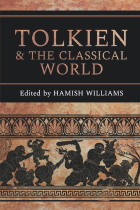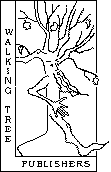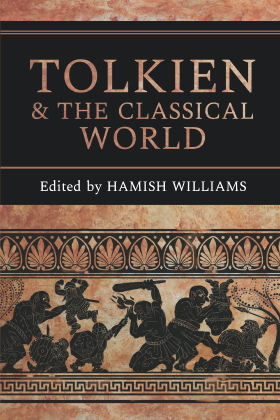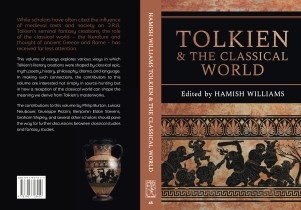Tolkien and the Classical World
Hamish Williams (editor)
Cormarë Series No. 45

<--previous | all publications | next-->
how to buy this item
 While scholars have often cited the influence
of medieval texts and society on J.R.R.
Tolkien's seminal fantasy creations, the role
of the classical world – the literature and
thought of ancient Greece and Rome – has
received far less attention.
While scholars have often cited the influence
of medieval texts and society on J.R.R.
Tolkien's seminal fantasy creations, the role
of the classical world – the literature and
thought of ancient Greece and Rome – has
received far less attention.
This volume of essays explores various ways in which
Tolkien's literary creations were shaped by classical epic,
myth, poetry, history, philosophy, drama, and language.
In making such connections, the contributors to this
volume are interested not simply in source-hunting but
in how a reception of the classical world can shape the
meaning we derive from Tolkien's masterworks.
The contributions to this volume by Philip Burton, Łukasz
Neubauer, Giuseppe Pezzini, Benjamin Eldon Stevens,
Graham Shipley, and several other scholars should pave
the way for further discussions between classical studies
and fantasy studies.
podcast | table of contents | abstracts | cover | announcements | more

The editor has produced a podcast / panel discussion on this book, which can be listened to here:
Alternatively the podcast can be opened directly on YouTube here:
youtube.com/watch?v=8MrLEX_yNSQ
podcast | table of contents | abstracts | cover | announcements | more

Hamish Williams
Editor's Notes
Hamish Williams
Classical Tradition, Modern Fantasy, and the Generic Contracts of Readers
SECTION 1: CLASSICAL LIVES AND HISTORIES
Hamish Williams
Tolkien the Classicist: Scholar and Thinker
(abstract)
Ross Clare
Greek and Roman Historiographies in Tolkien's Númenor
(abstract)
SECTION 2: ANCIENT EPIC AND MYTH
Giuseppe Pezzini
The Gods in (Tolkien's) Epic: Classical Patterns of Divine Interaction
(abstract)
Benjamin Eldon Stevens
Middle-earth as Underworld: From Katabasis to Eucatastrophe
(abstract)
Austin M. Freeman
Pietas and the Fall of the City:
A Neglected Virgilian Influence on Middle-earth's Chief Virtue
(abstract)
Peter Astrup Sundt
The Love Story of Orpheus and Eurydice in Tolkien's Orphic Middle-earth
(abstract)
SECTION 3: IN DIALOGUE WITH THE GREEK PHILOSOPHERS
Michael Kleu
Plato's Atlantis and the Post-Platonic
Tradition in Tolkien's Downfall of Númenor
(abstract)
Łukasz Neubauer
Less Consciously at First but More Consciously in the Revision:
Plato's Ring of Gyges as a Putative Source of Inspiration for Tolkien's Ring of Power
(abstract)
Julian Eilmann
Horror and Fury: J.R.R. Tolkien's The Children of Húrin
and the Aristotelian Theory of Tragedy
(abstract)
SECTION 4: AROUND THE BORDERS OF THE CLASSICAL WORLD
Philip Burton
"Eastwards and Southwards":
Philological and Historical Perspectives on Tolkien and Classicism
(abstract)
Richard Z. Gallant
The Noldorization of the Edain: The Roman-Germani Paradigm
for the Noldor and Edain in Tolkien's Migration Era
(abstract)
Juliette Harrisson
"Escape and Consolation": Gondor as the Ancient Mediterranean
and Rohan as the Germanic World in The Lord of the Rings
(abstract)
SECTION 5: SHORTER REMARKS AND OBSERVATIONS
Alley Marie Jordan
Shepherds and the Shire: Classical Pastoralism in Middle-earth
(abstract)
Oleksandra Filonenko and Vitalii Shchepanskyi
Classical Influences on the Role of Music in Tolkien's Legendarium
(abstract)
D. Graham J. Shipley
Afterword: Tolkien's Response to Classics in Its Wider Context
podcast | table of contents | abstracts | cover | announcements | more

Abstracts
INTRODUCTION
Classical Tradition, Modern Fantasy, and the Generic Contracts of Readers
SECTION 1: CLASSICAL LIVES AND HISTORIES
Tolkien the Classicist: Scholar and Thinker
This paper undertakes a biographic analysis of Tolkien as a Classicist, a study which can be roughly broken up into three parts: (1) his early education in Classics at King Edward's School in Birmingham and his initial undergraduate years at the University of Oxford; (2) his movement away from the prescriptive canon of Classics, especially during the First World War; and (3) his 'return' to Classics later in life as a means of thinking about the world, politics, art, and his own creative works.
Greek and Roman Historiographies in Tolkien's Númenor
Using classical reception theory, memory studies, and key works on the nature of historiography, I work in this paper to follow the trajectory of shadows, images, ideas, and fragments of antiquity scattered throughout Tolkien's descriptions of places, people, and events. In particular, both the island of Númenor and its inhabitants are treated by Tolkien with language reminiscent of Greek and Roman history. The first section of this study follows the story of classical Athens from its participation in the Persian Wars through to the end of its hegemony as told by Herodotus and Thucydides respectively, and it identifies the many ways in which both narrative content and the usage of language mirror the rise and fall of Númenor. The second section discusses the apparent influence of Roman imperial biographies on the chronology and characters of the Númenorean kings. Finally, the end of the Númenorean narrative is compared to the historiographies of Roman and early Christian writers charting the treatment of Christians by their imperial oppressors. Even as Tolkien was primarily concerned with constructing an original race and region influenced predominantly by Northern European culture and myth, a broad sweep of Graeco-Roman impressions may be found throughout this story.
SECTION 2: ANCIENT EPIC AND MYTH
The Gods in (Tolkien's) Epic:
Classical Patterns of Divine Interaction
The chapter focuses on patterns of divine interaction in Tolkien's works and their possible classical ancestry. Tolkien himself compared the Valar to the gods of "traditional" "higher" mythology (albeit with differences) and in 'The Cottage of Lost Play' he suggested that gods of classical mythology are indeed the Valar themselves, although mediated by the misleading representations of human beings. These correspondences do not only concern the Valar's identity and natural association (as is well known) but also encompass their activity within the narratives and, in particular, the ways they interact with non-divine (especially elvish and human) characters. While keeping in mind Tolkien's warning against focusing on the ox's bones rather than the soup, the chapter will thus investigate, through comparative analysis, the classical ancestry of Tolkien's patterns of divine interactions, and discuss how this source material has been "put to new uses": the ultimate aim is to reflect on the differences between Tolkien's secondary theology and that of his classical sources, and how these relate with the different narrative framework of Tolkien's legendarium.
Middle-earth as Underworld:
From Katabasis to Eucatastrophe
I examine how Tolkien draws on ancient stories of 'underworld journey' (katabasis) and 'encounter with the dead' (nekyia) to deepen central themes in his mythos, including 'loss', 'death', and 'forgetting'. Focusing on examples from The Silmarillion (such as the cosmic 'fall' of the Elves and Lúthien's descent into Angband) and The Lord of the Rings (such as Gandalf's combat with the Flame of Udûn, the Mines of Moria, and the Paths of the Dead), I argue that, whereas the ancient stories depict the ineluctability of death in the negative, for Tolkien everything is measured against the positive prospect of afterlife everlasting. In that context, even 'underworld journey' is a sign of 'intrinsic cosmic turn for the better', such that katabasis is linked to eucatastrophe.
Pietas and the Fall of the City: A Neglected
Virgilian Influence on Middle-earth's Chief Virtue
This paper examines how Virgil's concept of pietas ('pious duty'), especially as displayed in his narrative of the fall of Troy in Aeneid 2, exerts an influence (generally neglected by scholars) on Tolkien's own account of the virtues. In Part I, I examine the similarities between the fall of Troy and the fall of Gondolin, while in Part II, I undertake a reading of true and false displays of pietas in Minas Tirith. Finally, in Part III, I argue that Tolkien moves away from a Greek concern for kleos ('glory') toward a synthesis of three strands of ethical thought: the classical (pietas), the Northern (indomitable will), and the Christian (pistis or 'faith/trust'). He combines these into a virtue he terms estel. While the Northern and the Christian influence on Tolkien's theory of virtue is well established, it is this Virgilian element that provides the missing factor in Tolkien's magic spell. His defining virtue of estel, active trust and loyalty, is at once Classical, Christian, and English.
The Love Story of Orpheus and
Eurydice in Tolkien's Orphic Middle-earth
This paper explores the wider influence of the classical myth of Orpheus and Eurydice at the centre of Tolkien's fantasy world, encompassing both The Lord of the Rings and The Silmarillion. The already well-established links between Orpheus' myth and the narratives of Beren and Lúthien are also reconsidered in the context of the less apparently 'Orphic' narratives of Tom Bombadil and the ents. Through close intertextual echoes, it is argued that the classical narratives of Virgil's Georgics and Ovid's Metamorphoses are just as important as the medieval romance Sir Orfeo as sources of inspiration to Tolkien. Tolkien's reception will be seen to reflect his classical education, his real-life love-relationship with his wife, and his deep-felt love of music, poetry, and trees.
SECTION 3: IN DIALOGUE WITH THE GREEK PHILOSOPHERS
Plato's Atlantis and the Post-Platonic
Tradition in Tolkien's Downfall of Númenor
This paper analyses the relation between J.R.R. Tolkien's 'The Downfall of Númenor' and the Atlantis story as presented in Plato's dialogues Timaeus and Critias, after which Tolkien's story is assessed with regard to the post-Platonic Atlantis tradition. Finally, the paper suggests the purpose and the function of Tolkien's Atlantis reception.
The following chapter looks into the development of Tolkien's notion of the One Ring and argues that the Platonic ring of Gyges (as well as several other rings, both literary and real) may have provided him with various, not always immediately acknowledged ideas, gradually coming to light as he progressed with his work. Although these ideas may not always be identical with those of Plato, it cannot be denied that the two key notions which are put forth in the Republic – the invisibility it grants to its wearer and the corruption it fuels in his heart – are closely connected with the features that happen to be of foremost significance in connection with the One Ring in The Hobbit and The Lord of the Rings.
Horror and Fury: J.R.R. Tolkien's The Children of
Húrin and the Aristotelian Theory of Tragedy
The tale of Túrin has often been regarded by readers as somehow 'tragic', but this assumption has not really been analysed comprehensively in the context of the historic concepts of drama and tragedy. This paper interprets the story of Túrin through the framework of one of the most influential works in the history of European literary theory: Aristotle's Poetics. A close reading of The Children of Húrin (2007) highlights how Tolkien's story in many respects uses central elements of Aristotelian tragic theory in order to create a 'tragic' tale that evokes the strong emotional responses of pity and shock. Other elements of Greek tragedy found in Túrin's story include genuinely tragic situations as well as the portrayal of the main character as an individual who is largely responsible for his personal and familial tragedy due to his morally questionable actions and his intellectual misjudgments. Furthermore, we can find structurally important elements of Aristotle's Poetics such as peripeteia, anagnorisis, and pathos that all in all help to create a text that can rightly be called tragic.
SECTION 4: AROUND THE BORDERS OF THE CLASSICAL WORLD
"Eastwards and Southwards": Philological and
Historical Perspectives on Tolkien and Classicism
This chapter addresses the oblique nature of Tolkien's relationship to the 'classical world' as conventionally understood. It argues that Tolkien rejected alike views of the classical world as the source of 'Western civilization' and of northern Europe as home of the vigorous, expansionist Indo-Europeans. Rather we suggest that he is deeply influenced by a group of German scholars, notably Victor Hehn and Otto Schrader, who emphasized both the organic spread of Indo-European and the importance of wider cultural contacts across the Euroasiatic continent. With reference to the case-studies of plant and tree names, wine, dragons, and elephants, it is suggested that Tolkien was aware of the ways that each of these cut across traditional north-south and east-west divides. The later spread of Christianity continues these cross-cultural links even after the downfall of the 'classical world'.
As they come into contact with the Eldar, the wandering Edain of the First Age show a pattern of acculturation similar to the 'Romanization' that the Germanic confederations of the Migration Era showed while coming into contact with the Roman Empire. It is not a pattern that Tolkien set out to purposely introduce but rather the natural progression of a wandering people coming into contact and acculturating to a superior hegemonic presence. The Edain adopt Fingolfian norms and values as attested to in the various texts, but the texts are also written through the eyes of the Elvish chroniclers – through a lens of interpretatio noldoriana – and they narrate a process of Noldorization in the course of events during the First Age. This Noldorization consists of vassal relationships, military support and buffer zones, the education of aristocratic youth in Noldorin royal courts, the language acquisition of Sindar (the language of the Grey Elves), and the adoption of new Elvish-influenced traditions and material culture. In effect, the Edain confederation, like the Germanic confederations of the fourth and fifth centuries in the Roman Empire, progresses through a three-stage process which transform their political units from gentes (the three Edain houses) to a regnum (ultimately, Númenor).
The fictional cultures in Tolkien's world do not represent any single real-world culture, but they do draw inspiration from historical cultures in the real world. This chapter argues that part of the inspiration for the cultures of Gondor and Rohan and for their relationship with each other was the relationship between the ancient Mediterranean world (including the remnants of the Roman Empire) and the early medieval Germanic tribes to the north. However, whereas in real life these cultures came into conflict, Tolkien imagines a happier outcome, in which, in a moment of eucatastrophe, they work together against a common foe.
SECTION 5: SHORTER REMARKS AND OBSERVATIONS
Shepherds and the Shire:
Classical Pastoralism in Middle-earth
This chapter compares the pastoralism of Tolkien's hobbits in The Lord of the Rings and Virgil's shepherds in the Eclogues. Specifically, this chapter focuses on pastoralists' actions and their reflections on landscape during times of invasion and pollution in order to highlight shared characteristics between Tolkien's hobbits and Virgil's shepherds. The narrative of impending imperial power in classical pastoralism is important in order to illuminate pastoralism within The Lord of the Rings.
Classical Influences on
the Role of Music in Tolkien's Legendarium
The paper presents a brief survey of several Classical ideas on the role of music from the writings of Plato, Iamblichus, Cicero, Macrobius, and other ancient philosophers that might have infiltrated Tolkien's subcreation. Starting with the idea of Tolkien's world as kosmos (an object of beauty), the article proceeds with a comparative analysis of some roles music plays in Classical thought and Tolkien's legendarium: namely, a) a cosmogonic and cosmological force; b) a source of influence and magic; and c) a means of salvation. Particular attention is paid to Plato's Sirens and Fates, as represented in the Myth of Er, in comparison to Tolkien's Maiar, Ainur, and their influence on the fate of the world.
AFTERWORD
Afterword: Tolkien's Response to Classics in Its Wider Context
INDEX
podcast | table of contents | abstracts | cover | announcements | more

Cover
Cover illustration by Jay Johnstone
(click above views to enlarge)
podcast | table of contents | abstracts | cover | announcements | more

Announcements
Tolkien and the Classical World reviewed by SFRA Review (5th July 2023)
Many book reviews (12th April 2023)
Thersites reviews Tolkien and the Classical World (3rd April 2023)
Rosetta reviews Tolkien and the Classical World (3rd April 2023)
Anabases reviews Tolkien and the Classical World (3rd April 2023)
Book reviews in Mallorn (6th February 2023)
Lembas reviews Tolkien and the Classical World (18th April 2022)
Two books shortlisted for award (17th April 2022)
Three book reviews in Mythlore (16th April 2022)
Review of Tolkien and the Classical World (22nd March 2021)
Podcast by Hamish Williams (24th Jan 2021)
New publication, Tolkien and the Classical World (23rd Jan 2021)
Call for papers Tolkien and the Classical World (21st Jan 2019)

414 pages, Walking Tree Publishers 2021, Cormarë Series No. 45, Editor: Hamish Williams
, ISBN: 978-3-905703-45-0.

<--previous | all publications | next-->
how to buy this item

More on Tolkien and the Classical World

terms and conditions
visitors since 23.01.21
last updated 23.01.21


